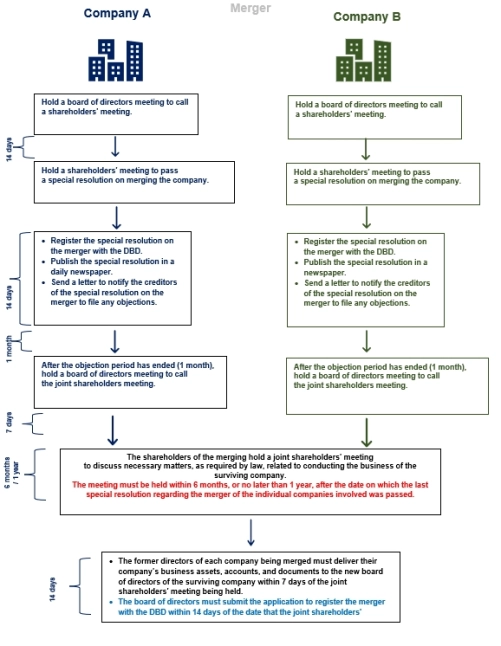eywords: Mazars, Thailand, legal, civil and commercial code, business combination, amalgamation, merger
7 March 2023
Previously, while amalgamations were allowed, mergers were not. However, the recent changes in the CCC now allow mergers as well. We set below more details, including changed or new provisions that apply to amalgamations and mergers.
Amalgamation
The CCC still allows two or more companies to be amalgamated into a new company, with the amalgamating companies being dissolved, and a new company being incorporated.
Merger
The CCC now also allows two or more companies to be combined, with one company being the surviving legal entity, with the others being dissolved (A + B = A or B). Under this structure, the surviving company takes over the dissolved company’s assets, rights, and liabilities.
The CCC also changed or added certain provisions related to amalgamations and mergers, as follows:
1. Buy out of shares of objecting shareholders | - Companies can find suitable buyers to buy out the shares of shareholders who object to the amalgamation or merger. The price of the shares to be sold must be agreed on between the buyer and the objecting shareholder.
- If the objecting shareholder and the buyer cannot agree on the sale price for the shares, the company must appoint an appraiser to evaluate the shares in accordance with the criteria to be set out in a Ministerial Regulation of the Ministry of Commerce (these criteria have not yet been issued).
- The prospective buyer must issue a written offer to the objecting shareholder specifying the price to be paid for the shares. The objecting shareholder must accept or reject this offer within 14 days of receiving it.
- If the objecting shareholder refuses to sell the shares to the buyer within this 14-day period, the company can proceed with the amalgamation or merger, and the objecting shareholder will become a shareholder of the amalgamated or merged company.
- This is a new provision.
| |
2. Objection period for creditors | - After the shareholders pass a resolution to amalgamate or merge the companies, the companies must publish the resolution in a daily newspaper and notify their creditors of such a resolution in writing within 14 days of the date on which the shareholders passed the special resolution.
- Objections by creditors must be made within one month of the date on which the creditor received notice of the resolution being passed by the shareholders.
| The objection period was reduced from 60 days to 1 month. |
3. Holding a joint shareholders’ meeting | - After the objection period has ended, the directors of the companies to be amalgamated or merged must call a joint shareholders’ meeting to consider the following matters:
- The name of the new or surviving company. This can be a new name or the name of one of the companies being amalgamated or merged.
- The business objectives of the new or surviving company.
- The share capital of the new or surviving company. The share capital must not be less than the share capital of the companies being amalgamated or merged.
- The allocation of shares to the shareholders.
- The memorandum of association of the new or surviving company.
- The articles of association of the new or surviving company.
- The election of directors of the new or surviving company.
- The appointment of the auditor of the new or surviving company.
- The joint shareholders’ meeting must be convened within 6 months of the date on which the last special resolution regarding amalgamation or merger of the individual companies involved was passed. If the joint shareholders’ meeting is postponed until after the six-month period for some reason, it must be held no later than one year after the last special resolution regarding amalgamation or merger of the individual companies involved was passed.
| This is a new provision. |
4. Forming a quorum and voting at the joint shareholders’ meeting | - In order for a quorum of the joint shareholders’ meeting to be formed, shareholders holding at least 50% of the total number of shares in each of the companies to be amalgamated or merged must be present.
- Resolutions of the joint shareholders’ meeting must be passed by a majority vote of the shareholders attending the meeting, unless they agree otherwise at the meeting.
| This is a new provision. |
5. Duties of the directors of the companies being amalgamated or merged | - The directors of each company being amalgamated or merged must deliver their company’s business assets, accounts, documents, and evidence of the company to the board of directors of the new or surviving company within 7 days of the joint shareholders’ meeting being held.
| This is a new provision. |
Timeline for amalgamation and merger





